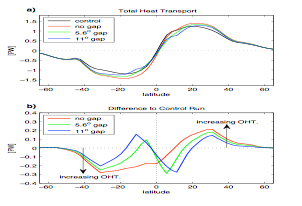HURRICANES
The heavy winds associated with tropical cyclones generate strong upper ocean mixing. Recent studies suggest that this enhanced mixing significantly contributes to the ocean poleward heat transport, mainly due to a strengthening
of the subtropical cells. However, the currently published literature makes the assumption that all heat pumped below the mixed layer by tropical cyclones is finally released in higher latitudes. In our research we questioned this assumption by addressing some overlooked characteristics of tropical cyclone induced ocean mixing.
The first regards the observation that tropical cyclones rarely occur polewards of about 10º. A general circulation model is used to show that if mixing is enhanced solely in the subtropical bands, where tropical cyclones are observed most of the heat taken up in the subtropics is transported into the equatorial strip, effectively reducing the poleward heat transport out of the deep tropics.
We are now investigating other aspects of the problem. Stay tuned.

References
Jansen, M., R. Ferrari, and T. Mooring, 2010: The effect of the seasonal cycle on heat anomalies generated in the wake of tropical cyclones, Geophys. Res. Lett., Vol. 37, L03602.
Jansen, M., and R. Ferrari, 2009: The latitudinal distribution of tropical cyclones and ocean heat transport, Geophys. Res. Lett., Vol. 36, L06604.


